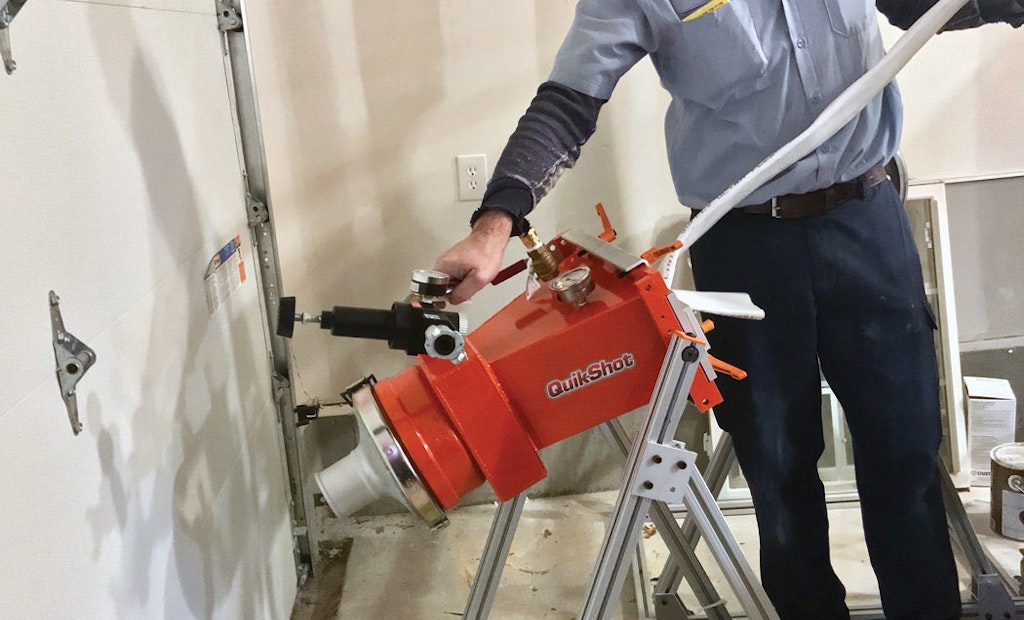
Rick Ramsey, owner of Affordable Plumbing & Sewer in Kansas City, Missouri, feeds a liner into a Quik-Shot inversion unit on a lateral lining job.
Interested in Relining/Rehab?
Get Relining/Rehab articles, news and videos right in your inbox! Sign up now.
Relining/Rehab + Get AlertsWhen it comes to equipment, master plumber Rick Ramsey believes more is more — as in more options to offer customers. That philosophy explains why the owner of Affordable Plumbing & Sewer in Kansas City, Missouri, owns two Quik-Shot pipe lining systems made by Pipe Lining Supply.
“If there’s a problem, I want to be the guy who’s able to fix it,” says Ramsey, who established his company in 1995 and provides service and repair plumbing, drain cleaning, and trenchless pipe bursting and lining services in the metro Kansas City area. “So I buy anything and everything that’s going to work and get the job done.”
Over the years, Ramsey has invested in many other pieces of drain cleaning and pipe rehab equipment made by Picote Solutions, Spartan Tool and GI Industries, plus SeeSnake inspection camera systems made by RIDGID. He bought his first Quik-Shot system about two years ago after a point repair lining job went south.
“One of the bladders blew up,” he explains. “The patch was fine, but I still had to finish the rest of the line. That’s when I started Googling for lining alternatives and ran across the Quik-Shot.”
A Pipe Lining Supply representative came to Kansas City to do a demonstration for Ramsey, who was impressed enough to buy a unit. About 14 months later, he bought another one. “It works really well,” says Ramsey, who runs 11 service vehicles and employs 10 people. “It’s so much less invasive than excavating, and all I need is one point of entry and I can shoot (a liner) up to 300 feet long.”
Solo strength
Simplicity and mobility are the Quik-Shot’s strengths. In fact, Ramsey says he commonly lines pipes by himself, which is unusual. The unit weighs about 50 pounds, which makes it easy to transport to hard-to-access places such as roofs, basements and narrow easements. “I even used one in a basement crawl space,” he says. “It’s very user-friendly.”
In a normal configuration, the machine stands only 36 inches high; in its smallest configuration, it will fit into a 12-by-12-by-24-inch opening. Contractors can use air pressure, supplied by a compressor, or water pressure — or both — to invert the liner.
The unit is engineered to use a minimum of moving parts, which reduces the chances of breakdowns. In addition, users can wet-out the epoxy liner, calibrate it (ensure the epoxy fully impregnates the liner at the correct thickness), and shoot it all in one process, which minimizes handling and streamlines the installation process.
“I just run the liner through the (calibration) rollers to get the correct thickness of epoxy,” he explains. “Then the ‘gun’ inverts the liner inside out so the epoxy-coated side goes against the pipe. Then I insert a calibration bag and run hot water (about 120 degrees F) through it to cure the epoxy. By the time I remove the calibration bag, the liner is about 70 percent cured.
“On average, I can do a 100-foot job in about six hours,” he continues. “That’s extremely good. That’s compared to about two days for pipe bursting and three days to excavate and repair.”
New market
Demand for pipe lining is strong in Kansas City, driven by the aging infrastructure that plagues so many large American cities. Most homes built before 1985 in the metro area have either Orangeburg, cast-iron, clay, or concrete sewer laterals — and the Quik-Shot can handle them all.
“I can shoot anything,” Ramsey says. “I regularly shoot two to three lines a week — and sometimes four. The great thing is being able to fix pipes under streets without tearing up pavement. Doing a street cut will cost at least $10,000, so the Quik-Shot gives me a big competitive advantage, plus it’s so versatile. It’s dramatically changed how I operate.”
Ramsey estimates he’s lined about 1,000 pipelines in the last two years and less than a dozen have gone south. The learning curve for using the Quik-Shot wasn’t steep; Ramsey says he felt comfortable after using it about 10 times within one month. “There always are issues that come up, but once you understand how the system works, you can overcome most of them.
“The thing is, once the genie is out of the bottle (the liner is inserted), there’s no going back,” he adds. “If your compressor or the gun breaks down, you’ve only got about 45 minutes after the liner is in to reinvert it and pull it out. You really have to pay attention to what you’re doing — be on your game all the time. It can be very stressful.”
On the other hand, Ramsey estimates that by opening up a new market for his company, the Quik-Shots have more than doubled his revenue, which means he has more than recouped the cost of the roughly $45,000 machine. “Financially, it’s been a game-changer,” he says.





